Or, “what can you learn about 270,000 records in a week?”
Guest post by Mia Ridge.
I’ve just finished a weeks’ residency at the Cooper-Hewitt, where Seb had asked me to look at ‘the shape of their collection‘. Before I started a PhD in Digital Humanities I’d spent a lot of time poking around collections databases for various museums, but I didn’t know much about the Cooper-Hewitt’s collections so this was a nice juicy challenge.
What I hoped to do
Museum collections are often accidents of history, the result of the personalities, trends and politics that shaped an institution over its history. I wanted to go looking for stories, to find things that piqued my curiosity and see where they lead me. How did the collection grow over time? What would happen if I visualised materials by date, or object type by country? Would showing the most and least exhibited objects be interesting? What relationships could I find between the people listed in the Artist and Makers tables, or between the collections data and the library? Could I find a pattern in changing sizes of different types of objects over time – which objects get bigger and which get smaller over time? Which periods have the most colourful or patterned objects?
I was planning to use records from the main collections database, which for large collections usually means some cleaning is required. Most museum collections management systems date back several decades and there’s often a backlog of un-digitised records that need entering and older records that need enhancing to modern standards. I thought I’d iterate through stages of cleaning the data, trying it in different visualisations, then going back to clean up more precisely as necessary.
I wanted to get the easy visualisations like timelines and maps out of the way early with tools like IBM’s ManyEyes and Google Fusion Tables so I could start to look for patterns in the who, what, where, when and why of the collections. I hoped to find combinations of tools and data that would let a visitor go looking for potential stories in the patterns revealed, then dive into the detail to find out what lay behind it or pull back to view it in context of the whole collection.
What I encountered
Well, that was a great plan, but that’s not how it worked in reality. Overall I spent about a day of my time dealing with the sheer size of the dataset: it’s tricky to load 60 meg worth of 270,000 rows into tools that are limited by the number of rows (Excel), rows/columns (Google Docs) or size of file (Google Refine, ManyEyes), and any search-and-replace cleaning takes a long time.
However, the unexpectedly messy data was the real issue – for whatever reason, the Cooper-Hewitt’s collections records were messier than I expected and I spent most of my time trying to get the data into a workable state. There were also lots of missing fields, and lots of uncertainty and fuzziness but again, that’s quite common in large collections – sometimes it’s the backlog in research and enhancing records, sometimes an object is unexpectedly complex (e.g. ‘Begun in Kiryu, Japan, finished in France‘) and sometimes it’s just not possible to be certain about when or where an object was from (e.g. ‘Bali? Java? Mexico?’). On a technical note, some of the fields contained ‘hard returns’ which cause problems when exporting data into different formats. But the main issue was the variation and inconsistency in data entry standards over time. For example, sometimes fields contained additional comments – this certainly livened up the Dimensions fields but also made it impossible for a computer to parse them.
In some ways, computers are dumb. They don’t do common sense, and they get all ‘who moved my cheese’ if things aren’t as they expect them to be. Let me show you what I mean – here are some of the different ways an object was listed as coming from the USA:
- U.S.
- U.S.A
- U.S.A.
- USA
- United States of America
- United States (case)
We know they all mean exactly the same place, but most computers are completely baffled by variations in punctuation and spacing, let alone acronyms versus full words. The same inconsistencies were evident when uncertainties were expressed: it might have been interesting to look at the sets of objects that were made in ‘U.S.A. or England’ but there were so many variations like ‘U.S.A./England ?’ and ‘England & U.S.A.’ that it wasn’t feasible in the time I had. This is what happens when tools encounter messy data when they expect something neat:
Data cleaning for fun and profit
I used Google Refine to clean up the records then upload them to Google Fusion or Google Docs for test visualisations. Using tools that let me move data between them was the nearest I could get to a workflow that made it easy to tidy records iteratively without being able to tidy the records at source.
Refine is an amazing tool, and I would have struggled to get anywhere without it. There are some great videos on how to use it at freeyourmetadata.org, but in short, it helps you ‘cluster‘ potentially similar values and update them so they’re all consistent. The screenshot below shows Refine in action.
One issue is that museums tend to use question marks to record when a value is uncertain, but Refine strips out all punctuation, so you have to be careful about preserving the distinction between certain and uncertain records (if that’s what you want). The suitability of general tools for cultural heritage data is a wider issue – a generic timeline generator doesn’t know what year to map ‘early 17th century’ to so it can be displayed, but date ranges are often present in museum data, and flattening it to 1600 or 1640 or even 1620 is a false level of precision that has the appearance of accuracy.
When were objects collected?
Having lost so much time to data cleaning without resolving all the issues, I eventually threw nuance, detail and accuracy out the window so I could concentrate on the overall shape of the collection. Working from the assumption that object accession numbers reflected the year of accession and probably the year of acquisition, I processed the data to extract just the year, then plotted it as accessions by department and total accessions by year. I don’t know the history of the Cooper Hewitt well enough to understand why certain years have huge peaks, but I can get a sense of the possible stories hidden behind the graph – changes of staff, the effect of World War II? Why were 1938 and 1969 such important years for the Textiles Department, or 1991 for the Product Design and Decorative Arts Department?
Or try the interactive version available at ManyEyes.
I also tried visualising the Textiles data as a bubble chart to show the years when lots of objects were collected in a different way:
Where are objects from?
I also made a map which shows which countries have been collected from most intensively. To get this display, I had to remove out any rows that had values that didn’t exactly match the name of just one country, etc, so it doesn’t represent the entire collection. But you can get a sense of the shape of the collection – for example, there’s a strong focus on the US and Western Europe objects.
The interactive version is available at https://bit.ly/Ls572u.
This also demonstrates the impact of the different tools – I’m sure the Cooper-Hewitt has more than 43 objects from the countries (England, Scotland, Wales and Northern Ireland) that make up the United Kingdom but Google’s map has only picked up references to ‘United Kingdom’, effectively masking the geo-political complexities of the region and hiding tens of thousands of records.
Linking Makers to the rest of the web
Using Refine’s Reconciliation tool, I automatically ‘reconciled’ or matched 9000 names in the Makers table to records in Freebase. For example, the Cooper-Hewitt records about Gianni Versace were linked to the Freebase page about him, providing further context for objects related to him. By linking them to a URL that identifies the subject of a record, those records can now be part of the web, not just on the web. However, as might be expected with a table that contains a mixture of famous, notable and ordinary people, Refine couldn’t match everything with a high level of certainty so 66453 records are left as an exercise for the reader.
I also had a quick go at graphing the different roles that occurred in the Makers table.
The benefit of hindsight, and thoughts for the future
With hindsight, I would have stuck with a proper database for data manipulation because trying to clean really large datasets with consumer tools is cumbersome. I also would have been less precious about protecting the detail and nuance of the data and been more pragmatic and ruthless about splitting up files into manageable sizes and tidying up inconsistencies and uncertainties from the start. I possibly should have given up on the big dataset and concentrated on seeing what could be done with the more complete, higher quality records.
The quality of collections data has a profound impact of the value of visualisations and mashups. The collections records would be more usable in future visualisations if they were tidied in the source database. A tool like Google Refine can help create a list of values to be applied and provide some quick wins for cleaning date and places fields. Uncertainty in large datasets is often unavoidable, but with some tweaking Refine could also be used to provide suggestions for representing uncertainty more consistently. I’m biased as crowdsourcing is the subject of my PhD, but asking people who use the collections to suggest corrections to records or help work through the records that can’t be cleaned automatically could help deal with the backlog. Crowdsourcing could also be used to help match more names from the various People fields to pages on sites like Freebase and Wikipedia.
If this has whetted your appetite and you want to have a play with some of Cooper-Hewitt’s data, check out Collection Data Access & Download.
Finally, a big thank you to the staff of the Cooper-Hewitt for hosting me for a week.

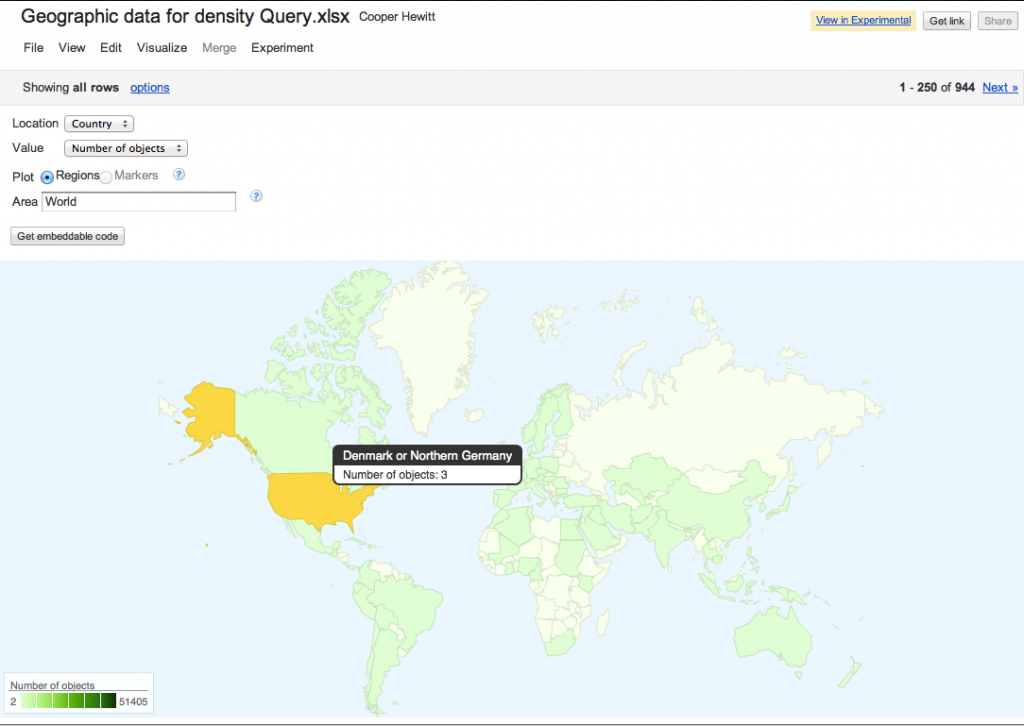
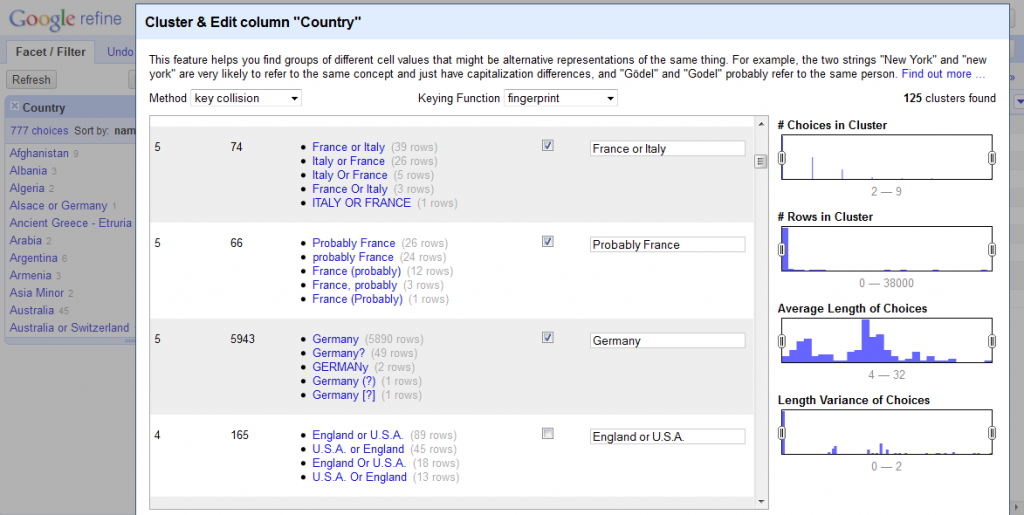
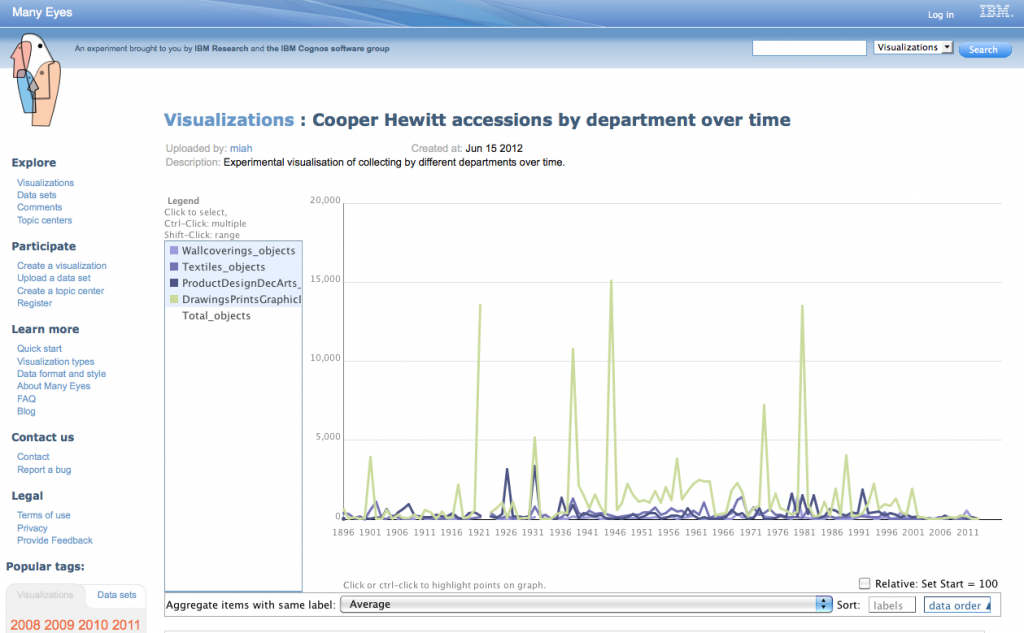
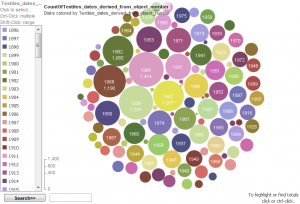
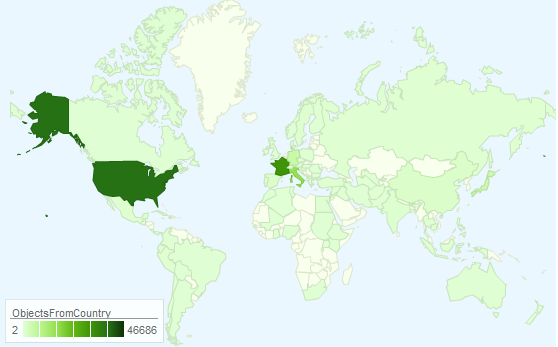
Also check out Patrick Murray-John’s similar experience at #ThatCamp – https://www.cooperhewitt.org/2012/patrick-murray-john-hacks-collection-thatcamp/
Data dump vs API?
This is a conversation that has been going on for years. Luke Dearnley at Powerhouse Museum in Sydney covers a lot of this territory in his paper from Museums and the Web 2011 – http://www.museumsandtheweb.com/mw2011/papers/reprogramming_the_museum
It should really be data dump AND API.
Great post Mia. Will the Cooper-Hewitt re-ingest your consistent data?
That’s the plan.
It is going to need more normalisation and clean up before we can do it but the nice thing about Refine is the ability to save the methods used.
I’ve got to say that the Powerhouse data is so rich and clean compared to almost every other museum’s data. You guys should be proud of that – ad do more with it!
And I’d be wary about ingesting some of my cleaned data as in the end a lot of it was probably over-cleaned in the aid of getting a workable set of data.
Pingback: Editors’ Choice: Exploring the Cooper-Hewitt Collection Round-Up : Digital Humanities Now
Thanks for the detailed post of your experience with the collection data, Mia. I teach cataloging and metadata and one of the most difficult things for students to grasp is why punctuation, vocabulary control and conceptual discreteness is so critical. Your post will certainly help in this regard.
Having spent several years “cleaning” a data set of 30,000 image records at an academic institution I felt your pain! Do you have any plans to speak to someone at the Cooper Hewitt about what you found for verification? I am wondering specifically about the large accessions of textiles in specific years.
Also, I am trying to pull together speakers for a proposal I am working on about visualizing cultural data that will take place next spring. Any interest?
Hi Joan, I’m glad to hear my post might help! I gave an internal presentation of my findings to Cooper-Hewitt staff so hopefully they can at least implement some of the quick wins in data cleaning. I’d love to know more about why there are spikes in accessions – I thought some might be donations or perhaps times when they were dealing with cataloguing backlogs.
I’m usually based in the UK but I’m curious to hear more about your proposal. It’s probably easiest to email me via http://www.miaridge.com/contact/
Cheers, Mia
Pingback: Scholar-in-residence, Cooper-Hewitt | mia ridge
Pingback: Notes on D-Lib Article on Visual Interfaces to Cultural Heritage Collection Data | Jefferson Bailey
Pingback: Resources for ‘Data Visualisation for Analysis in Scholarly Research’ | mia ridge
Pingback: Messiness, museums and methods: thoughts from #DH2012 so far… | archaeoinaction.info
Pingback: Mia Ridge on the Maker Movement | librarydata
Pingback: Messiness, museums and methods: thoughts from #DH2012 so far... - Open Objects
Pingback: Crowdsourced Assets on Open Knowledge | TiaMart Blog
Pingback: Two weeks in the Lab | DX Lab